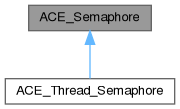Wrapper for Dijkstra style general semaphores. More...
#include <Semaphore.h>

Public Member Functions | |
| ACE_Semaphore (unsigned int count=1, int type=USYNC_THREAD, const ACE_TCHAR *name=0, void *=0, int max=0x7fffffff) | |
| Initialize the semaphore, with initial value of "count". | |
| ~ACE_Semaphore () | |
| Implicitly destroy the semaphore. | |
| int | remove () |
| int | acquire () |
| int | acquire (ACE_Time_Value &tv) |
| int | acquire (ACE_Time_Value *tv) |
| int | tryacquire () |
| int | release () |
| int | release (unsigned int release_count) |
| int | acquire_read () |
| int | acquire_write () |
| int | tryacquire_read () |
| int | tryacquire_write () |
| int | tryacquire_write_upgrade () |
| void | dump () const |
| Dump the state of an object. | |
| const ACE_sema_t & | lock () const |
| Return the underlying lock. | |
Public Attributes | |
| ACE_ALLOC_HOOK_DECLARE | |
| Declare the dynamic allocation hooks. | |
Protected Attributes | |
| ACE_sema_t | semaphore_ |
| bool | removed_ |
Private Member Functions | |
| void | operator= (const ACE_Semaphore &)=delete |
| ACE_Semaphore (const ACE_Semaphore &)=delete | |
Detailed Description
Wrapper for Dijkstra style general semaphores.
Constructor & Destructor Documentation
◆ ACE_Semaphore() [1/2]
| ACE_Semaphore::ACE_Semaphore | ( | unsigned int | count = 1, |
| int | type = USYNC_THREAD, | ||
| const ACE_TCHAR * | name = 0, | ||
| void * | arg = 0, | ||
| int | max = 0x7fffffff ) |
Initialize the semaphore, with initial value of "count".
◆ ~ACE_Semaphore()
| ACE_Semaphore::~ACE_Semaphore | ( | ) |
Implicitly destroy the semaphore.
◆ ACE_Semaphore() [2/2]
|
privatedelete |
Member Function Documentation
◆ acquire() [1/3]
|
inline |
Block the thread until the semaphore count becomes greater than 0, then decrement it.
◆ acquire() [2/3]
|
inline |
Block the thread until the semaphore count becomes greater than 0 (at which point it is decremented) or until tv times out (in which case -1 is returned and errno == ETIME). Note that tv is assumed to be in "absolute" rather than "relative" time. The value of tv is updated upon return to show the actual (absolute) acquisition time.
◆ acquire() [3/3]
|
inline |
If tv == 0 then call <acquire()> directly. Otherwise, Block the thread until the semaphore count becomes greater than 0 (at which point it is decremented) or until tv times out (in which case -1 is returned and errno == ETIME). Note that <*tv> is assumed to be in "absolute" rather than "relative" time. The value of <*tv> is updated upon return to show the actual (absolute) acquisition time.
◆ acquire_read()
|
inline |
Acquire semaphore ownership. This calls <acquire> and is only here to make the ACE_Semaphore interface consistent with the other synchronization APIs.
◆ acquire_write()
|
inline |
Acquire semaphore ownership. This calls <acquire> and is only here to make the ACE_Semaphore interface consistent with the other synchronization APIs.
◆ dump()
| void ACE_Semaphore::dump | ( | ) | const |
Dump the state of an object.
◆ lock()
|
inline |
Return the underlying lock.
◆ operator=()
|
privatedelete |
◆ release() [1/2]
|
inline |
Increment the semaphore by 1, potentially unblocking a waiting thread.
◆ release() [2/2]
Increment the semaphore by release_count, potentially unblocking waiting threads.
◆ remove()
|
inline |
Explicitly destroy the semaphore. Note that only one thread should call this method since it doesn't protect against race conditions.
◆ tryacquire()
|
inline |
Conditionally decrement the semaphore if count is greater than 0 (i.e., won't block). Returns -1 on failure. If we "failed" because someone else already had the lock, errno is set to EBUSY.
◆ tryacquire_read()
|
inline |
Conditionally acquire semaphore (i.e., won't block). This calls <tryacquire> and is only here to make the ACE_Semaphore interface consistent with the other synchronization APIs. Returns -1 on failure. If we "failed" because someone else already had the lock, errno is set to EBUSY.
◆ tryacquire_write()
|
inline |
Conditionally acquire semaphore (i.e., won't block). This calls <tryacquire> and is only here to make the ACE_Semaphore interface consistent with the other synchronization APIs. Returns -1 on failure. If we "failed" because someone else already had the lock, errno is set to EBUSY.
◆ tryacquire_write_upgrade()
|
inline |
This is only here to make the ACE_Semaphore interface consistent with the other synchronization APIs. Assumes the caller has already acquired the semaphore using one of the above calls, and returns 0 (success) always.
Member Data Documentation
◆ ACE_ALLOC_HOOK_DECLARE
| ACE_Semaphore::ACE_ALLOC_HOOK_DECLARE |
Declare the dynamic allocation hooks.
◆ removed_
|
protected |
Keeps track of whether remove() has been called yet to avoid multiple remove() calls, e.g., explicitly and implicitly in the destructor. This flag isn't protected by a lock, so make sure that you don't have multiple threads simultaneously calling remove () on the same object, which is a bad idea anyway...
◆ semaphore_
|
protected |
The documentation for this class was generated from the following files: